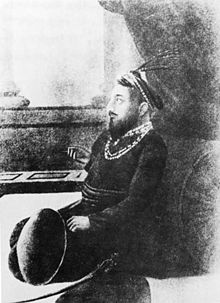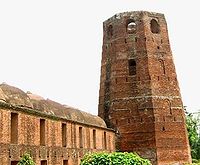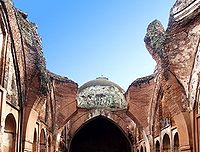- Murshid Quli Khan
-
Murshid Quli Khan Mutaman ul-Mulk, Ala ud-Daula, Nawab Jaafar Khan Bahadur Nasiri, Nasir Jang, Nawab Nazim of Bengal and Orissa 
Reign 1717–1727 Coronation Nawab since 1717 Full name Murshid Quli Khan (Muhammad Hadi / Mirza Hadi) Born c. 1665 Birthplace most probably in Orissa or the Deccan Died June 30, 1727 Place of death Murshidabad Buried Katra Masjid, Murshidabad Predecessor Mughal Empire Successor Sarfaraz Khan / Shuja-ud-Din Muhammad Khan Wife Nasiri Banu Begum Sahiba Offspring Nawabzada Yahya Khan (son)
Azmat un-nisa Begum Sahiba (Zinat un-nisa) (daughter)
Zainab un-nisa Begum Sahiba (daughter)Dynasty Nasiri Father Haji Shafi Isfahani (foster father) Religious beliefs Islam Murshid Quli Khan (Bengali: মুর্শিদ কুলি খান) was the first Nawab of Bengal. In fact circumstances resulted in his being the first independent ruler of Bengal post the death of Emperor Aurangzeb. Though he continued to recognize the nominal overlordship of the Mughal Emperor, for all practical purposes he was the Nawab of Bengal.
Contents
Evolution of the position of the Nawab of Bengal
The decay and downfall of the Mughal Empire began in right earnest after the reign of Aurangzeb. The Peacock Throne in Delhi became a "musical chair" for the successors of Aurangzeb and fueled by court intrigues of numerous nobles the tenure between 1707 and 1719 saw no less than eight Mughal Emperors (more than the sum of the last 180 years) namely Bahadur Shah I, Jahandar Shah, Farrukh Siyar, Rafi ud-Darajat, Rafi ud-Daulah, Neku Siyar, Muhammad Ibrahim and finally some stability came in the form of Muhammad Shah in 1719.
Such instability saw the rise of three notable nobles; Saadat Ali Khan the Subahdar of Oudh, Murshid Quli Khan the Subahdar of Orissa and Nazim of Bengal and Qamar ud-din Khan (also known as Asaf Jah I) the Subahdar of Deccan.
The distinguishing factor in these three nobles were that all were decorated generals of Aurangazeb and were old timers and unlike the "newer" nobles in the Red Fort; never got actively involved in court intrigues and were always on the "right" side of the Mughal Emperor, however weak the emperor might be. In stead these three nobles concentrated in entrenching themselves in their respective territories. Gradually while Delhi became weaker Oudh, Hyderabad / Deccan and Bengal became strong and prosperous. This was the direct outcome of the resources in Delhi getting strained due to the frequent changes of Emperors in Delhi. Every Mughal Emperor henceforth became more and more dependent on the three nobles and the nobles cleverly and tactfully extracted more and more for their "loyalty" till the time they became de-facto and then the de-jure rulers or Nawabs of the territories. The final blow came in 1724, when Nizam ul-Mulk, Asaf Jah I declared himself the Nizam of Hyderabad.
Meanwhile Murshid Quli Khan was gradually consolidating his position. In 1717, he renamed his capital city from Makhsusabad to Murshidabad (after himself). The then Mughal Emperor Farrukh Siyar granted formal approval to this (symbolic) change of name, paving the way for Murshid Quli Khan to become the de-facto Nawab of Bengal. He however continued to "act and function" as the viceroy of the ever weakening Mughal Emperor.
Early life
There are two versions of his early life. One version is that he was grandson of the Maratha general Mohammed Quli Khan (formerly Netaji Palkar) by his Iranian wife Nusrat Banu, daughter of Mughal Vazir Asad Khan.
The second and most reliable version is that he was born a poor Oriya Brahmin in the Deccan, brought up by Haji Shafi Isfahani, a merchant from Isfahan, who converted and renamed him Muhammad Hadi / Mirza Hadi.[1] He entered the service of Haji Abdullah, Diwan of Berar, later transferring to Royal service under Emperor Aurangzeb.
Rise to power
He was strictly Muslim, and an officer of honesty and integrity. He had already held the office of Diwan of the Subah of Orissa. In several Mahals pertaining to Orissa he had effected retrenchments in expenditure, and had thus become prominent amongst the Imperial officials. He was held matchless in probity and rectitude of purpose. Rendering eminent services in taxation, in periods of siege and war, he had got into the good graces of Emperor Aurangzeb.
In the year 1703 the Mughal Emperor Aurangzeb, invited Murshid Quli Khan and presented him the Kaftan of honor, a kettledrum band, a crescent standard and appointed him with the rank of Mansabdar of 2000 Matchlocks and 1000 Sowars. Mughal Faujdars such as Kartalab Khan and Azim-ud-din were placed under his authority.[2]
At that period, the reins of the administration of Financial and Revenue affairs, the power over the assessment and collection of revenue, and payments into and disbursements from the Imperial Treasury lay in the hands of the Diwan of the Subah.
The Nazim had jurisdiction over the Procedure and Administration of Political affairs, such as the repression and chastisement of the refractory and the disobedient, and the extirpation of rebels and tyrants. Except with regard to the Jagirs attached to the Nizamat and personal Mansabs and presents, the Nazim had no power to meddle with the Imperial revenue.
Conflict with Prince Azim-us-Shan
Murshid Quli, being appointed by Emperor to be Diwan of the Subah of Bengal, arrived at Jahangir Nagar (present-day Dhaka). After waiting on the Prince Azim-us-Shan, the grandson of Emperor Aurangzeb, he devoted himself to the administration of the fiscal affairs. All the transactions of the Treasury was in charge of Murshid Quli. The Prince's control over the income and expenditure were ceased. This led him to the path of direct conflict with Prince Azim-us-Shan wherein the Prince attempted to assassinate Murshid Quli Khan. Aurangzeb, detecting possible rebellions, acted quickly shifting Azim-us-Shan to Patna (later renamed to Azimabad) and Murshid Quli to Makhsusabad (which Murshid Quli Khan later renamed to Murshidabad). This happened in 1703. This is sometimes erroneously referred to as the year of transfer of the capital of the Subah Bengal from Dhaka to Murshidabad. The whole process actually took fifteen years (1703–1717). Murshidabad was the capital from 1717 to 1780.
His efficient revenue control and military administration and in proving his good and faithful services, Quli Khan became the recipient of further imperial favours. He became Deputy to the Prince in the Nizam of the Subah of Bengal and Orissa, in addition to the office of Diwan. He was also given the title of Murshid Quli Khan and further received a valuable Khilat with a standard and a kettle-drum.
During the reign of Aurangzeb and after it, Murshid Quli's rise was meteoric. From the Diwan of Hyderabad, Bengal (1700–1708 and 1710–1713), Bihar, Deccan (1708–1710), Naib Nazim of Bengal (1713–1717), Subahdar of Orissa (1714), and Nazim of Bengal (1717). Removed his headqaurters from Dhaka to Makhsusabad in 1703, and renamed it Murshidabad in 1717. By then, his power was overwhelming and the Mughal influence on Bengal was wiped out. The then Mughal Emperor, Farrukhsiyar, granted formal approval to this symbolic change of name and from then on Murshid Quli Khan became the de-facto Nawab of Bengal. He celebrated this by opening a mint in Murshidabad and issued in his name the Zurbe Murshedabad coin and other coins.[3]
Reign
Murshid Quli never formally severed his links to the Mughals and continued to send annual tribute to Delhi. Although he laid the foundation of a well-run and economically viable state, it was his successor who made the rupture with Delhi.
Post 1717, Mushid Quli set about resolving matters of state, with an "iron fist", very aggressively most of the times and with an undue heavy hand on others. As an administrative decision, Midnapore was separated from Orissa and annexed to the Subah of Bengal.
Revenue collection
On matters of revenue collection Murshid Quli was absolutely non-compromising to the extent of being ruthless. Hindu Zamindars especially suffered under his rule and were terrorized by the Nawab and his Amils (Collectors of Revenue). In aggressively collecting revenue, both current and arrears he put a complete stop to the authority of Zamindars over the collection and disbursement of the imperial revenue, he limited their source of income to profits of Nankar (tax-free lands give in consideration for services rendered) tenures. Accordingly a new revenue roll (some say a Perfect Roll before the permanent settlement of Bengal) was drawn up.
Land and agrarian reforms
On matters of land reforms, the Amils (collectors of revenue) under his orders, sent Shiqdars and Amins to every village of the Parganas, measured the cultivated and waste-lands, and leased them back to tenants, plot by plot, and advanced agricultural loans (Taqavi) to the poorer tenantry, and put forth exertions for increase in the produce of the lands. Thus Murshid Quli affected not only increase in revenue, but also increase in their areas.
He ensured that a part of the revenues were remitted to the imperial treasury in Delhi. Till the time of Aurangzeb the entirety was remitted to Delhi but post 1717 this remittance was limited to the annual tribute (Nazrana).
His administration was so vigorous and successful that there was neither foreign incursion nor internal disturbance, and consequently the military expenditure was nearly abolished.
Personality
Murshid Quli Khan was very powerful as a personality and his commands were so overawing that his peons sufficed to keep peace in the country, and to overawe the refractory. And fear of his personality was so deeply impressed on the hearts of all, both the high and the low, that the courage of lion-hearted persons quailed in his presence. He did not allow petty Zamindars access to his presence. The Mutsadis and Amils and the leading Zamindars had not the heart to sit down in his presence; on the contrary, they remained standing breathless like statues. Hindu Zamindars were forbidden to ride on Palkis. The Mutasadis, in his presence, did not ride on horseback ; whilst the Mansabdars attended at state functions in their military uniforms. In his presence one could not salute another; and if anything opposed to etiquette occurred on the part of anyone, he was immediately censured. Every week he held court on two days to listen to complaints, and used to mete out justice to the complainants. Amongst his deeds of justice, it may be mentioned, that to avenge the wrong done to another, obeying the sacred Islamic law, he executed his own son.[citation needed] In administration of justice, in administration of the political affairs of the country, and in maintenance of the respect due to the Mughal Emperor, he spared no one. Murshid Quli Khan's uprightness in administration of justice (regardless of all family ties of attachment) is remarkable.
In brief Murshid Quli was no better or no worse than quite a few Muslim rulers who set up kingdoms in India but most certainly he enhanced the material prosperity of Bengal in terms of revenue.
Death and succession
Murshid Quli Khan died on 30th June 1727 (1139 A.H.) according to Riyaz-us-Salatin by Ghulam Husain Salim. However Encyclopaedia Britannica suggests that the year was 1726.
In absence of a direct heir, he nominated his maternal grandson Sarfaraz Khan to succeed him. It is highly likely that Sarfaraz Khan ascended to the Masnad as Nawab Nazim before abdicating in favour of his father Shuja-ud-Din Muhammad Khan. On hearing of Sarfaraz's accession to the Masnad, his father, Shuja-ud-Din Muhammad Khan, the Dewan Nazim of Orissa, marched at the head of a large army towards Murshidabad. To avoid a conflict in the family, the dowager Begum of Murshid Quli Khan intervened; and her son-in-law Shuja-ud-Din Muhammad Khan ascended to the masnad of Bengal.
By the end of 1727, Shuja-ud-Din Muhammad Khan was firmly established as the Nawab of Bengal.
Murshid Quli Khan lies buried below the steps of Katra Masjid, a mosque in Murshidabad.[4] He laid the foundation of the Nasiri dynasty which would last for another thirteen years.
Preceded by
Mughal EmpireNawab of Bengal
1717–1727Succeeded by
Shuja-ud-Din Muhammad KhanSee also
References
- Abdul Karim (1963), Murshid Quli Khan and His Times
- Catherine Ella Blanshard Asher, Cynthia Talbot, India before Europe
- Ghulam Hussein Salim, Riyaz-us-Salatin
- Mir Gholam Hussein-Khan Tabtabai, Siyar-ul-Mutakherin
Notes
- ^ Concise Encyclopaedia Of World History, By Carlos Ramirez-Faria, pg. 528
- ^ http://books.google.com/books?id=HHyVh29gy4QC&printsec=frontcover&dq=mughal+empire&hl=en&ei=jS7ITsPxBMa2hAfhy83xDw&sa=X&oi=book_result&ct=result&resnum=1&ved=0CDIQ6AEwAA#v=onepage&q=mughal%20empire&f=false
- ^ History of Murshidabad
- ^ History Of Bengal India,History Of Bengal Region,Bengal History Phase
Categories:- Nawabs of Bengal
- 1727 deaths
- Converts to Islam
Wikimedia Foundation. 2010.


